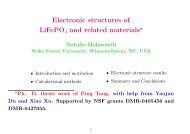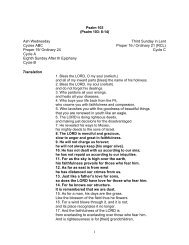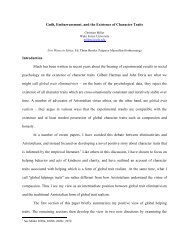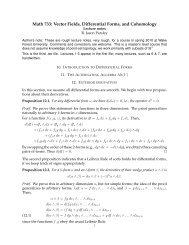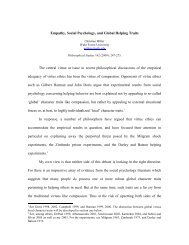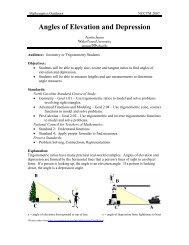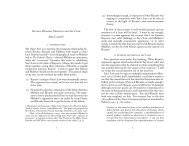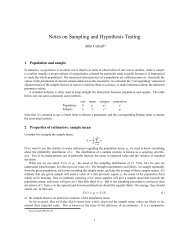Nonnegativity Constraints in Numerical Analysis - CiteSeer
Nonnegativity Constraints in Numerical Analysis - CiteSeer
Nonnegativity Constraints in Numerical Analysis - CiteSeer
You also want an ePaper? Increase the reach of your titles
YUMPU automatically turns print PDFs into web optimized ePapers that Google loves.
Block pr<strong>in</strong>cipal pivot<strong>in</strong>g algorithm:Input: A ∈ R m×n , b ∈ R mOutput: x ∗ ≥ 0 such that x ∗ = arg m<strong>in</strong> ‖Ax − b‖ 2 .Initialization: F = ø and G = 1, . . . , n, x = 0, y = −A T b, and p = 3, N = ∞.repeat:1. Proceed if (x F , y G ) is an <strong>in</strong>feasible solution.2. Set n to the number of negative entries <strong>in</strong> x F and y G .2.1 Proceed if n < N,2.1.1 Set N = n, p = 3,2.1.2 Exchange all <strong>in</strong>feasible variables between F and G.2.2 Proceed if n ≥ N2.2.1 Proceed if p > 0,2.2.1.1 set p = p − 12.2.1.2 Exchange all <strong>in</strong>feasible variables between F and G.2.2.2 Proceed if p ≤ 0,2.2.2.1 Exchange only the <strong>in</strong>feasible variable with largest <strong>in</strong>dex.3. Update x F and y G by Equation (10) and (11).4. Set Variables <strong>in</strong> x F < 10 −12 and y G < 10 −12 to zero.Interior Po<strong>in</strong>t Newton-like Method:In addition to the methods above, Interior Po<strong>in</strong>t methods can be used to solve NNLSproblems. They generate an <strong>in</strong>f<strong>in</strong>ite sequence of strictly feasible po<strong>in</strong>ts converg<strong>in</strong>g to thesolution and are known to be competitive with active set methods for medium and largeproblems. In the paper [1], the authors present an <strong>in</strong>terior-po<strong>in</strong>t approach suited for NNLSproblems. Global and locally fast convergence is guaranteed even if a degenerate solution isapproached and the structure of the given problem is exploited both <strong>in</strong> the l<strong>in</strong>ear algebraphase and <strong>in</strong> the globalization strategy. Viable approaches for implementation are discussedand numerical results are provided. Here we give an <strong>in</strong>terior algorithm for NNLS, moredetailed discussion could be found <strong>in</strong> the paper [1].Notation: g(x) is the gradient of the objective function (6), i.e. g(x) = ∇f(x) =A T (Ax − b). Therefore, by the KKT conditions, x ∗ can be found by search<strong>in</strong>g for thepositive solution of the system of nonl<strong>in</strong>ear equationsD(x)g(x) = 0, (12)12



